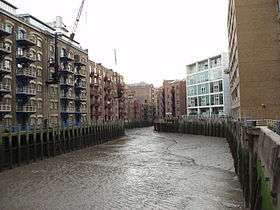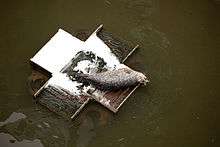St Saviour's Dock
St Saviour's Dock is a small inlet-style dock in London, England, on the south bank of the River Thames, 420 metres east of Tower Bridge. It forms the eastern end of the picturesque and incrementally increased embankment that starts at Tower Bridge known as Shad Thames. The east side of the Dock is Jacob's Island.



Geography
The dock has had since its excavation a high tidal range, with today a maximum recorded rise and fall of four metres. Furthest inland the bed of the inlet is about one metre above the low-tide mark of the Thames so is empty at many low tides. It was often at low tide slightly watered before 1894 as a final head of water along the Thames is maintained above Richmond footbridge and more surface water drains in Southwark ran into it. The maximum high tide is regulated by use of the Thames Barrier which usually enables the water to stay more than 1 foot (0.30 m) below the embankments. During exceptional tidal surges where the Barrier proves insufficient water levels have topped the walkways adjoining buildings on Shad Thames and Mill Street. The long rectangular inlet opens to the river 420 metres east of Tower Bridge.[1]
St Saviour's Dock is the point where the vestige of the River Neckinger enters the Thames, one of the most reduced subterranean rivers, more of a standard surface water drain today. In the past it described further inlets or outlets to the west.[2]
History
A community of Cluniac monks resided at elevated Bermondsey Abbey south-east of the site from 1082 onwards. The community began the development of the marshes surrounding their abbey at Bermondsey, cultivating the land and embanking the riverside into a Priory Close spanning 140 acres of meadow and digging dykes. They turned the adjacent tidal inlet at the mouth of the River Neckinger into the priory's dock, and named it Saint Saviour's Dock after their abbey's patron. This provided a safe landing for Bishops and goods below the traditional first land crossing, the congested stone arches of London Bridge.[2] According to the Winchester Episcopal Register, the Bishop of Winchester when returning from abroad was expected to land at Bermondsey shores.[3]
John Stow, a 16th-century English historian and antiquarian had the following to say about the area,
"In the south end whereof[n 1] was sometime a priory or abbey of St. Saviour, called Bermond's Eye[n 2] in Southwark, founded by Alwin Childe, a citizen of London, in the year 1081."
St Saviour's in the Arts
Charles Dickens set portions of his novel Oliver Twist in the area of Shad Thames, at a time when it was an area of notorious poverty known as Jacob's Island. He set Bill Sikes's den at the east of Shad Thames in buildings adjacent to St Saviour's Dock. It is here that Sykes falls from a roof and dies in the mud, probably of St Saviour's Dock.
Dickens gives us a vivid description of what this unsavoury place must have looked like at the time of the novel,
- ". . . crazy wooden galleries common to the backs of half a dozen houses, with holes from which to look upon the slime beneath; windows, broken and patched, with poles thrust out, on which to dry the linen that is never there; rooms so small, so filthy, so confined, that the air would seem to be too tainted even for the dirt and squalor which they shelter; wooden chambers thrusting themselves out above the mud and threatening to fall into it - as some have done; dirt-besmeared walls and decaying foundations, every repulsive lineament of poverty, every loathsome indication of filth, rot, and garbage: all these ornament the banks of Jacob's Island."
St Saviour's dock was also featured in the 2002 videogame The Getaway, serving as the final area in the game for both characters' campaigns.
Notes and references
- References
- Grid reference Finder measurement tools
- H.E. Malden (editor) (1912). "Parishes: Bermondsey". A History of the County of Surrey: Volume 4. Institute of Historical Research. Retrieved 22 November 2012.CS1 maint: extra text: authors list (link)
- Winchester Episcopal Register, Pontoise, fol. 155a
- Notes
- Whereof means of which
- Pronounced /eɪ/ as in its extended form eyot which is also commonly spelt ait.